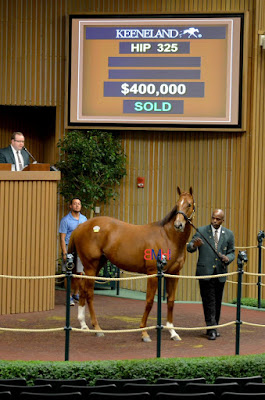The Doubt Edged Sword of Social Media
For years, sports have been jumping on the social media bandwagon to
reap the benefits of interacting with fans in a way that wasn't possible even 10 years ago.
Over the last year, horse racing has finally embraced the social media aspect
with open arms and has worked towards creating a more fan friendly sport. Farms use sites such as Twitter and Facebook to keep fans
up-to-date on their runners and even some famous retired stock. On the track,
jockeys and trainers use it to give updates on not only their barns but also
their lives.
But with all the benefits that have come with social media, it also has some negative sides as well.
The most recent example of the "other side" of social media is the saga of three-year-old colt Paynter and his whereabouts.
From his victory in the Haskell until he was “found” by a journalist at the Mid-Atlantic Equine Medical Center, Twitter was abuzz about where the horse had gone.
From his victory in the Haskell until he was “found” by a journalist at the Mid-Atlantic Equine Medical Center, Twitter was abuzz about where the horse had gone.
While trainer Bob Baffert was quiet about the horse on Twitter, only
posting that he was doing well after spiking a fever, Justin Zayat, Paynter’s owner’s son responded to tweets
saying that Paynter was “healthy and sound”.
After the news broke that Paynter was at the clinic, Zayat posted videos of the horse at the clinic to
show that he was, for the most part, fine. Baffert then broke his silence to
give an update as to when the horse would be returning to the track,
showing that the trip to the clinic wasn’t as serious as it seemed.
When the horse shipped to Belmont on August 10, Zayat posted a picture
of the horse in his stall
to prove that the horse really was back at the track.
While the Paynter drama seems to be moving into the past, the same connections are dealing with the brewing of a storm over their other three-year-old, Bodemeister.
The second place finisher of the Kentucky Derby and Preakness is undergoing tests at Rood and Riddle this week. However, unlike Paynter, "Bode's" condition has been pretty forthcoming, letting the Zayat's experience the "highs" and "lows" of feedback when providing information on social media.
While the Paynter drama seems to be moving into the past, the same connections are dealing with the brewing of a storm over their other three-year-old, Bodemeister.
The second place finisher of the Kentucky Derby and Preakness is undergoing tests at Rood and Riddle this week. However, unlike Paynter, "Bode's" condition has been pretty forthcoming, letting the Zayat's experience the "highs" and "lows" of feedback when providing information on social media.
Another high profile horse went through this same drama earlier in the
year when it was leaked that Rachel Alexandra and her colt had been sent to Rood and Riddle for pain management.
The tweet later disappeared and a statement was released by Stonestreet
about the issue.
It’s also doubtful any Zenyatta fans can forget the tweet that came at
11:07pm on March 8 announcing the birth of Zenyatta’s foal. But the information
didn’t come from the official Zenyatta blog; instead it came from Bill Farish’s
daughter Daisy… yet again on social media.
Twitter and Facebook have been amazing tools for the horse racing industry
to utilize. The platform has allowed contests have been held, pictures to be
sent, and racing personalities to interact with fans.
In addition, it has also allowed the sport to get more exposure when related names and events "trend" on the national stage. Overall, social media has been amazing for the sport.
But it also allows for more chances of news to slip out that isn’t intended for public view right then.
In addition, it has also allowed the sport to get more exposure when related names and events "trend" on the national stage. Overall, social media has been amazing for the sport.
But it also allows for more chances of news to slip out that isn’t intended for public view right then.
While social media shouldn’t disappear from racing, the sport does
need to adapt in order to give the fans “exclusive access” while also keeping
private matters private.
The biggest issue with that rule is where to draw the line when it comes to equine information. After all, even if fans (and the media) feel a certain attachment to these animals, the bottom line is that they are privately owned.
The biggest issue with that rule is where to draw the line when it comes to equine information. After all, even if fans (and the media) feel a certain attachment to these animals, the bottom line is that they are privately owned.
This is definitely one of those issues that can take the sport in two
different ways. But it is one that needs to be dealt with in order to deal with
the privacy of animals and their owners while also keeping the horse from “disappearing”
and losing fans after it leaves the track.
It will definitely be interesting to see where that line is drawn and
how it will affect horse racing in coming years.


Comments
Post a Comment